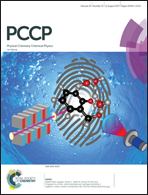Distinct solvent- and temperature-dependent packing arrangements of anti-parallel β-sheet polyalanines studied with solid-state 13C NMR and MD simulation†
Abstract
Polyalanine (polyA) sequences are well known as the simplest sequence that naturally forms anti-parallel β-sheets and constitute a key element in the structure of spider and wild silkworm silk fibers. We have carried out a systematic analysis of the packing of anti-parallel β-sheets for (Ala)n, n = 5, 6, 7 and 12, using primarily 13C solid-state NMR and MD simulation. HFIP and TFA are frequently used as the dope solvents for recombinant silks, and polyA was solidified from both HFIP and TFA solutions by drying. An analysis of Ala Cβ peaks in the 13C CP/MAS NMR spectra indicated that polyA from HFIP was mainly rectangular but polyA from TFA was mainly staggered. The transition from the rectangular to the staggered arrangement in (Ala)6 was observed for the first time from the change in the Ala Cβ peak through heat treatment at 200 °C for 4 h. The removal of the bound water was confirmed by thermal analysis. This transition could be reproduced by MD simulation of (Ala)6 molecules at 200 °C after removal of the bound water molecules. In this way, the origin of the stability of the different packing arrangements of polyA was clarified.



 Please wait while we load your content...
Please wait while we load your content...